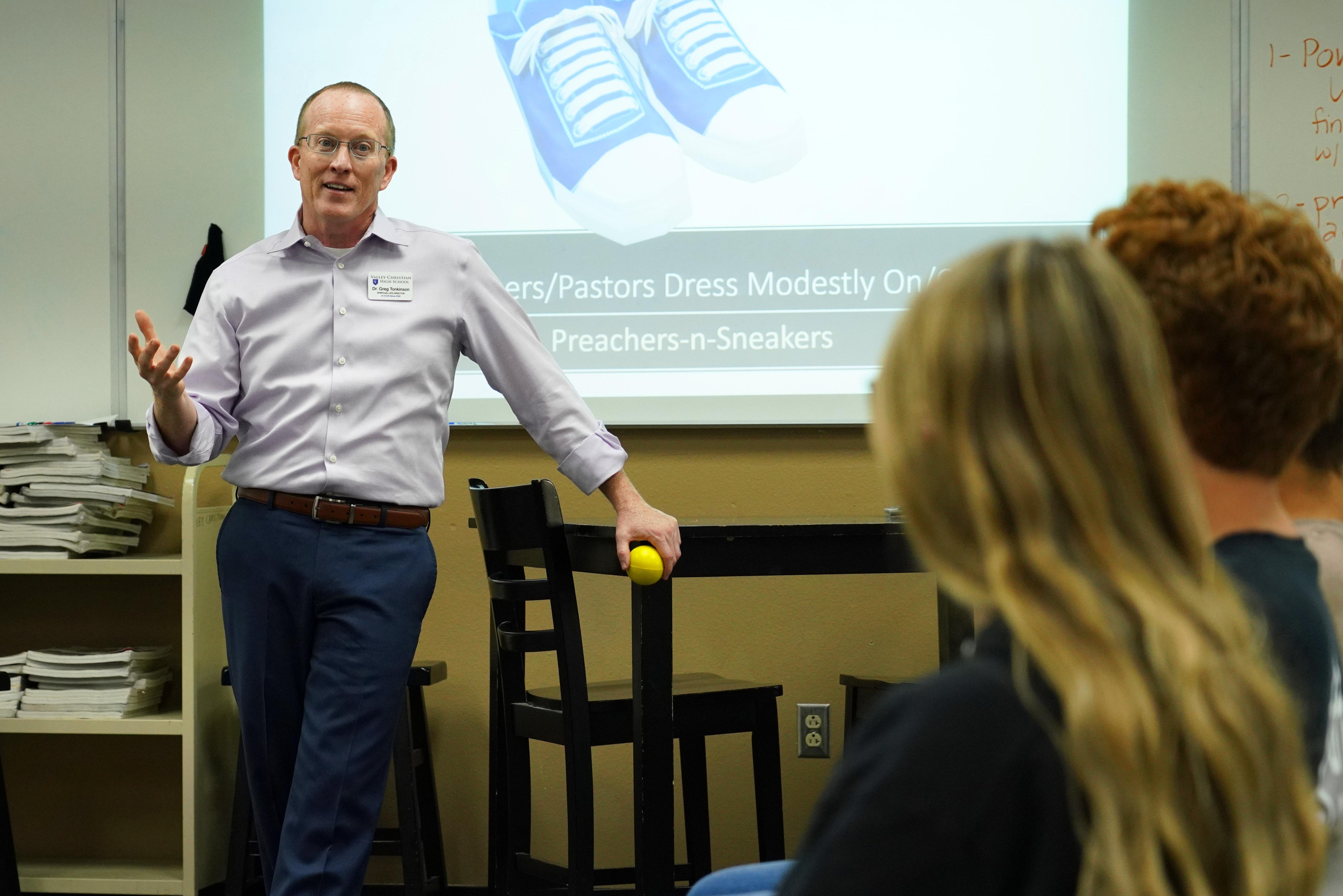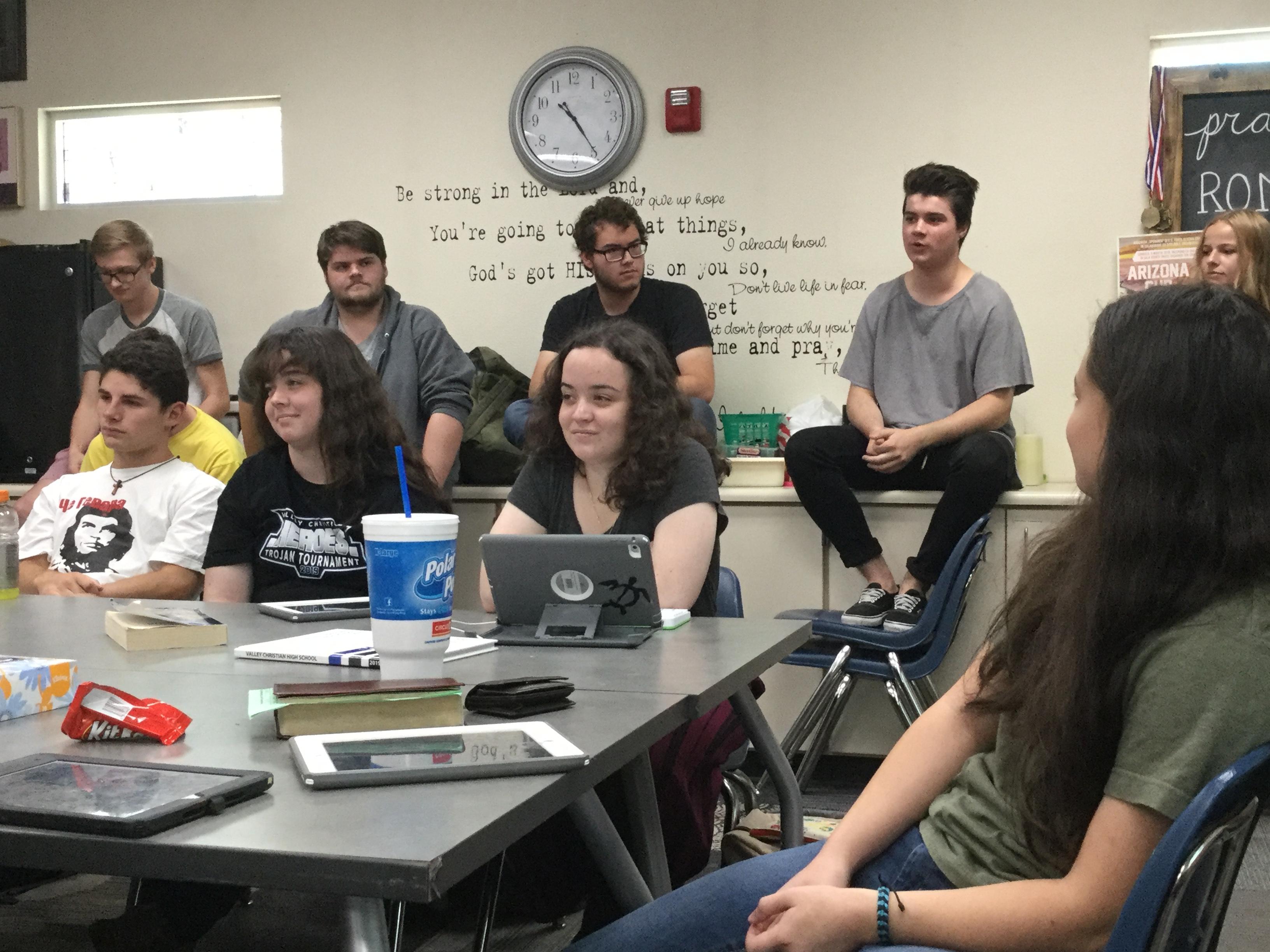Valley Christian High School has been making shifts in its Bible instruction, comparable to those taking place in math and science around the country. VCHS is aiming for greater hands-on engagement with the Bible by coaching students in the skills of the discipline, leading them to ask questions and make discoveries, and then share their findings with one another so they apply their knowledge more deeply.
“We recently introduced a reader’s version of Scripture to all four grade levels,” Greg said, “with the desire that students read through the entire Bible by the time they graduate.” The teachers are seeking to do less lecturing and more coaching, so that students are practicing the skills of observation, interpretation, and application as they make their way through Scripture.
Bryant Russ, department head at Holland Christian School in Michigan, has noted a trend of schools like VCHS. “In the past, Bible instruction was tied to the person teaching it, but with modern turnover and younger teachers, there’s been more conversation about how to teach Bible,” Bryant said. “The cultural landscape has changed. It’s less ‘guaranteed’ that students will be Christians after they leave. So, as a department, we’ve been trying to share best practices and learn about skill-based instruction. I’ve sensed that shift in other schools, too.”
We asked Greg to share how he restructured his senior-level course for greater student engagement. Here are six tips we gathered:
1. Collaborate with Administrators
To restructure a course around greater student engagement, start by speaking with your administrators. Many schools are seeking to implement standards about skill-based learning and formative assessments, so they welcome greater use of these tools in Bible class.
For Greg, the journey began when he asked his 17-year-old son, “If you could create a Bible course, what would it look like?” His son said that rising seniors wanted to discuss contemporary moral issues in a safe place where they could share an opinion but also learn more facts and theology on those issues. Greg pondered that idea and felt that his son was right. “Teens today desperately need an environment where they can talk openly about challenging issues, while also receiving accurate, biblical instruction,” Greg said. He approached his administration with his idea for this class, and they supported the creation of a new course named “18 Questions.”
2. Prepare Topics, Resources & Modes-of-Learning Your Course Will Utilize
Bible courses created for higher engagement and skill-based learning often revolve around these pieces of student work:
- Reading of primary sources (Bible, articles)
- Watching teacher model skills (reading, interpretation, etc.)
- Practicing skills, as the teacher circulates to coach
- Short written work—recording findings and summarizing material
- Sharing findings in discussion or presentation
- Lengthier, thoughtful writing to bring learning together
- Teacher-led instruction at various spots in the cycle
- Feedback and assessment along the way
Greg worked to hone the cycle of learning for his course. “The trick was to figure out how to give enough information so students can make informed opinions without lecturing, which would take away from an honest peer-to-peer discussion,” he explained. He landed on a cycle where students begin exploring each issue through primary source readings that include Scripture and pro/con articles on a topic. They prepare their first short responses as written posts in an online forum, and then they have deeper peer-to-peer discussion, which Greg facilitates using certain protocols. He saves interactive lecture for late in the learning cycle, to summarize, reflect, and wrap-up.
3. Provide Direction As Students Engage with Primary Sources
Students typically need accountability to complete required reading, but better than “reflection questions”—which students may skip right to—is to help students read closely and well. You might ask them to summarize the argument in short written form, or you might teach them how to mark up a text as they read, noting the author’s keywords, points of emphasis, as well their own questions and reactions. A visually marked-up text can function as a “summary.” Either way, before moving on to deeper discovery and discussion, see that students have engaged with the primary source.
At Valley Christian, much of the work of Scripture analysis takes place in prior grade levels. As students read through Scripture throughout high school, they are asked to Observe details in the text, Interpret and make connections, and then Apply. “By senior year, they should be ready to apply their hermeneutical skills to Scripture, articles, and primary sources with the attempt to form convictions on important topics,” Greg said.
4. Structure How Students will Share Their Discoveries
For students to have rich discussions, protocols need to be in place. In fact, many skills of active listening and collaborative discussion take practice and coaching.
Greg prepares students for discussion by, first, requiring students to briefly summarize their readings and submit a written reflection, prior to class. Students post in an online forum and are required to cite the author and the Scripture in their posts. They must also respond to someone else so that they have done some thinking and interacting prior to the formal class discussion. This step creates higher outcomes. Instructors may assess the written preparation, the discussion, or both.
The seniors at VCHS spend two back-to-back periods in discussion of the readings. Greg sets out rules for discussion in advance and arranges seating in a particular way, reminding students to look at one another rather than at him. Greg uses positional seating, with the two sides of the room representing opposite perspectives, and then asks students to sit where they believe the answer to be.
“My goal is to step out of the discussion as much as possible because it is beneficial for students to wrestle through an issue themselves,” Greg shared. “My greatest satisfaction comes in hearing students verbally cite the authors during the discussion.”
5. Follow up with a Concise, Interactive Lecture
When restructuring his course, Greg moved teacher-instruction to the end of the learning cycle. After several days of inquiry, his students now appreciate his perspective as they would not have before. Similarly, Bryant Russ found that when his lectures preceded inquiry, he was “giving answers to questions no one was even asking.” Both men have found lecture to be most effective either to provide tools to get students going or as a wrap-up to what they learned.
Length is also an issue. When Greg was coached before giving a TED talk, he learned he had to be more concise and deliver his content in under eighteen minutes. TED has found that audiences focus better in relatively short chunks. Listeners need variety and a break from one voice, so Greg intentionally places 3–4 discussion questions, dispersed throughout his content.
“Rather than uni-directional (simply dispensing information), I work to lead students stepwise through a reasoning process: to show rather than tell.” Greg can incorporate comments and questions students made during the week so that he is continuing the dialogue. Students can hear a mature theological perspective, yet one that is relational and includes their voice.
6. Champion Why Bible Class Benefits from Engagement
Many students and families celebrate hands-on learning in Bible class. But some may worry that student inquiry will end up simply pooling everyone’s subjective opinions (and ignorant ones!). Or what if one student leads the class toward a negative viewpoint?
Teachers do need skills in facilitating and structuring hands-on learning. (See training at the CSI Bible Instruction Symposium) Yet the planning is worth it. Students can experience both richer engagement and biblical content—with more personal meaning, due to engagement.
“I’ve heard the worry that class will go the wrong direction, but it’s never played that way out,” Greg shared. The times that the discussion becomes raw, he has seen students lean in and learn the most. “That’s real life! Real life conversations are not canned and guided, and in my opinion, students are wanting more ‘real life’ in the classroom,” he said.
To miss out on student engagement is itself “unsafe.” If students do not share their questions and learn from committed believers while in high school, how will they be prepared for a secular environment? Research shows that, if we want to persuade Gen Z toward a certain belief, then involving them in dialogue is actually more important than whether we give a compelling argument. (1) Young people, more than ever, are drawn to truth communicated with collaboration and vulnerability, rather than to just a “strong” argument.
References
1. Summit Ministries. “Role Models: The Importance of Relationships and Modeling Christianity for Gen Z - Dr. Jeff Myers.” YouTube video, 33:19. October 3, 2019. https://www.youtube.com/watch?v=VAWTiwKJHWk&;t=1649s
Written by Heidi Dean

TED talk coaching helped Greg become a more concise presenter.

Greg uses interactive lecture at the end of the learning cycle.

Student discussion plays a major role in the learning cycle. Students sit on the side of the room representing the side of the argument they lean toward.

Learning to face one other, listen, and respond politely to disagreement helps students gain maturity.